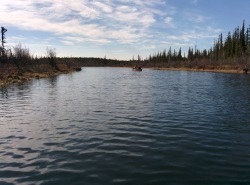Student Travel Diary: Sally Western

On May 15th 2016 I flew to the Northwest Territories to conduct archival research for my Major Research Project at the Territorial Archives in Yellowknife. Though my supervisors, Arn Keeling and John Sandlos, had retrieved a large body of material from their past research trips to Yellowknife, my focus on public health and toxic regulation around Giant Mine in the 1980s and 1990s warranted a new visit.
I’m as new to the Canadian arctic as I am to academic history. When I first applied to graduate programs, I was sure I would end up in the Pacific Northwest or Rocky Mountain regions of the United States, but the arctic struck me with its allure of adventure and ice. I wanted to find polar bears atop pristine icebergs, downing freshly killed walrus beneath the midnight sun. And yet, nothing could be further from this image than archival research. Even in Yellowknife, their archives are suspiciously devoid of bears, wolves, walrus, icebergs, or other grandiose icons drawn from the Northern Imaginary.
In the archives I met 'finding aids', and file numbers, and other foreign categories of organization. I traced natural resource regulation duties that had been passed along three or four times in the past fifty years, beginning with the “Department of Resources and Development” and finally ending with the office of “Environment and Natural Resources.” I wore latex gloves and worked only in full-view of the archival technician keeping watch from the front desk. It apparently takes more than just getting to the arctic to grasp its thrills.
After a few days grappling with the finer points of shuffling paper, I had my first research trip break-through: I wrangled an invitation on a canoe trip. I knew none of the people going except for Alex, a Geochemist Masters student from Queens University, whom I had met the night before. I knew that Yellowknife had a particular culture of inclusivity and so did not hesitate to take a three-day trip into the Boreal Forest with a group of strangers. Other members of the trip were quick to loan sleeping bags, tents, and canoe space.
Above 60 degrees latitude, the sun in late May shines from about 3:30 am to 11:30 pm, and never allows total darkness. We spent our days paddling, and exploring small islands, with many hours left for cooking, and chatting around the camp fire. Out of eight trip-goers, six were visiting Yellowknife for research: four Environment Canada ornithology interns; Alex, my new geochemist friend; and me. And so the weekend became an immersive field trip.
“Geochemistry” was never a term that inspired my enthusiasm (nor have birds), but the canoe trip offered a chance to see what the NWT looked like in “hard-science” terms. I learned about arctic terns and sand pipers and Sandhill cranes, and why the Northwest Territories has so many lakes and marshes (the short answer is glaciers). But most importantly, Alex’s research examines Giant Mine as a potential present-day source of community arsenic exposure.
Because the site still contains substantial arsenic surface contamination, each spring the tailings-storage areas are covered with a “chemical surfactant” in order to prevent the wind from disturbing the arsenic dust. But in May the ground is too cold to apply the surfactant and the tailings are left exposed. Alex’s thesis examines the arsenic content of the resultant dust which then blows through the city of Yellowknife.
Historically and at present, Arsenic trioxide, the form produced as a by-product from Giant’s gold roasting process, is the greatest pollution concern at Giant Mine. This type of arsenic has been a public health concern, to one degree or another, since the late 1940s when the mine opened. After reading through my archival findings on debates over toxicity and arsenic in the 1980s and 90s, I wonder what would happen if Alex finds significant quantities of arsenic trioxide in this dust. How will she define “significant quantities? How would the NWT Department of Environment and Natural Resources?
By the 1990s in Yellowknife, federal and territorial regulators had accepted that arsenic was carcinogenic even at low-doses, but debates continued over what constituted a health risk significant enough to justify the costs of reducing it—i.e. the cost of modifying roasting and stack equipment and hiring new employees.
In present day Yellowknife, for similar reasons, there still remains ample room for debate over what constitutes significant arsenic exposure risk. Today, just as the 1990s, arsenic remains on the Federal Priority Substance List, yet the Canadian Air Act offers no enforceable regulation on air quality. It is up to territorial regulators to weigh scientific evidence against economic feasibility and community concern.
My paper chiefly examines how regulators mobilized evolving frameworks of scientific knowledge and risk management in the last 25 years of Giant Mine’s operation. But the tension between scientific findings and regulatory agendas were hardly resolved when Giant closed in 1999. Alex’s research brought to light one potential example. Kvetching aside, the territorial archives provided ample material to study scientific and political discourse from earlier decades. But my trip to Yellowknife also instilled my work with interdisciplinary and experiential breadth. Like the ever-evolving concepts of toxicity, exposure, technological remedies, and regulatory solutions, the material legacy of the mine lives on.
And no, I never saw a polar bear or walrus on the canoe trip. But the company and conversation more than made up for it.